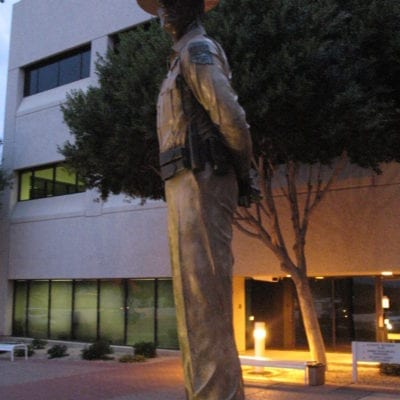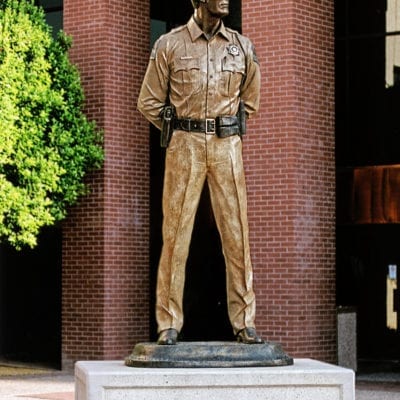Author: Mike Wood
A dramatic video from an officer-involved shooting this week has garnered a lot of attention on PoliceOne and elsewhere in the law enforcement community.
In the video, an officer pursuing a pair of murder suspects is fired upon by the criminals from their fleeing SUV. The officer returns fire through his own windshield while driving his police car in pursuit.
Thankfully, the officer was not injured in the shooting and the incident was successfully resolved. One suspect was killed by police at the termination of the pursuit when he tried to run over the officers with the SUV, and the other suspect was arrested later, after fleeing the scene.
The work’s not over yet
I am grateful that the officers involved in this incident were not injured and that the criminals were apprehended. I also join the ranks of PoliceOne readers and other law enforcement professionals – including the assistant sheriff of this agency – who have praised the officers for their aggressive pursuit of these dangerous criminals, and their dedication to protecting the community from them.
However, now that the incident is over, it is appropriate to consider the tactics displayed in the video, and the implications for future incidents. Although we seem to be experiencing a spike in similar activity lately, it’s uncommon for officers to fire from a moving vehicle during a pursuit, more uncommon for officers to fire while simultaneously acting as the driver, and even more uncommon yet for officers to fire through their own windshield at suspects, so it makes sense to learn what we can from this rare incident. What do we want law enforcement officers to take away from this event, particularly with respect to shooting from a moving vehicle?
Consider the risks
First, we must emphasize that a police officer is required to constantly balance the risks of his actions against the potential reward. There may indeed be tactical circumstances where the reward makes it appropriate for an officer to shoot through his own windshield while driving after a dangerous suspect, but there are many risks associated with this kind of action. Police officers must be cognizant of these risks at all times, and include them as part of their decision-making process. Officers weigh risks and make decisions based on the circumstances (as they are known to them), the law, their training, their experience, their department policies, ethical considerations and their personal knowledge when they’re choosing appropriate tactics to employ.
What are some of the risks an officer should consider in this scenario?
1. Losing control of the police vehicle.
If an officer is trying to split his attention between shooting and driving, they cannot fully concentrate on either. Things happen quickly when driving, and it’s entirely possible an officer could crash while their attention is diverted away from operating the police vehicle, or while their hands are full of gun instead of steering wheel.
2. Striking an innocent with the police vehicle.
Similarly, an officer runs the risk of striking an uninvolved pedestrian or vehicle when attention is diverted away from operating the emergency vehicle. You cannot focus on your front sight and your surrounding environment at the same time, particularly at pursuit speeds.
3. Injury potential from stray rounds.
Hitting a moving target when you’re stationary is difficult. Hitting a moving target when you’re also moving is even more difficult. Most of you serve in agencies where you’re lucky if any of your training regularly involves shooting while your feet are moving, and it’s highly unlikely that any of you serve in agencies that teach you how to shoot from a moving vehicle, so some of you may not fully appreciate how difficult it is to achieve a good, fight-stopping hit in this scenario. The complexity of making a good hit on the suspect at pursuit speeds cannot be overestimated, and the odds of missing your target are exceptionally high in a scenario where you’re shooting at a moving and maneuvering vehicle from another moving and maneuvering vehicle, especially if you’re simultaneously trying to drive. Added to this, your ability to remain aware of your background is severely hampered when driving at pursuit speeds, because the environment is changing so rapidly. These factors combine to create a nightmare scenario, where the officer is not only likely to miss the target, but to also be unaware of innocents in the background who may be injured by rounds that miss the target.
4. Injury potential from ricochets.
Vehicles are robust and bullets are not. While a bullet may indeed penetrate a vehicle if the conditions are right (angles, impact location), they may also ricochet off the surface or break up on the surface and spray dangerous fragments at unpredictable angles which can injure innocents.
5. Suspect losing control of vehicle.
If you’re successful in targeting the criminal occupants of the vehicle, you may cause them to lose control of the vehicle. Once this happens, it’s anybody’s guess where it will wind up and what it will hit. If the suspect loses control of the vehicle on a busy road or in a populated area, many innocents could be injured in the resulting crash.
Consider the tactical implications
Besides the risks, an officer must also consider the ways that the tactical situation could play out if they choose to shoot at a moving suspect vehicle. It’s possible that shooting at the suspect vehicle may be ineffective, may enhance the danger to the officer, or may provoke a more dangerous reaction from the suspect that puts the public at greater risk. Consider tactical issues such as the following:
1. Only good hits count.
The proper target is the suspect. Putting holes in the vehicle accomplishes very little, unless you fire the “golden BB” that disables it – which is highly unlikely with a handgun, shotgun, or 5.56x45mm patrol rifle. National hit averages in police gunfights have hovered in the teens since we started keeping track, and that’s with feet planted on terra firma. Vehicle-to-vehicle engagements offer an even lower promise of good hits, particularly if you’re shooting through your own windshield. Until your concentrated fire puts a big enough hole in the windshield to shoot through without interruption, the laminated safety glass will have a dramatic effect on the trajectory of the rounds you fire, making it extremely difficult to put accurate rounds on targets beyond the end of your car’s hood.
2. Depleting your ammo supply.
Your chances of making good hits are low, but your chances of wasting your ammunition are exceptionally high with each shot fired. It would do you little good to reach the end of a pursuit with a weapon that’s empty or close to it, particularly if the occupants came out fighting. If a pursuit terminates in a gunfight, you’ll wish you had all those rounds back in your gun or pouch, instead of a pile of spent brass on the floorboard.
3. Negligent discharge.
Your risk of a negligent discharge while shooting and driving is dramatically increased. It’s awkward to maneuver a weapon around the obstacles in the cabin of a police car (dashboard, steering wheel, radio rack, computer, long gun rack, seatbelt) and in the stress of the event, you’re even more likely to abandon good trigger finger discipline. Shooting or fragging yourself (or a partner) with a negligent discharge won’t help you win the fight.
4. Cover degradation.
If you put holes in your windshield with outgoing fire, that makes it easier for incoming fire to get to you. It also simplifies the marksmanship problem for the enemy, because his rounds are more likely to travel straight, without deflection.
5. Visibility.
Shooting through your own windshield will make it even more difficult for you to see out of it, which isn’t a good thing in the middle of a pursuit. The restricted visibility may make it more difficult to drive safely, and may also make it more difficult to observe the suspects and their actions.
6. Hearing loss.
Shooting your firearm inside of a vehicle will probably damage your ears, causing both short- and long-term hearing loss. Your hearing loss may be so acute that you’ll have difficulty hearing the radio as the pursuit continues, or communicating with the suspects and other officers at the end of the chase, robbing you of important sensory inputs.
7. Glass injuries.
Shooting through your laminated windshield will create glass dust that can get in your eyes and lungs, causing injuries that may impair vision, disable you, or create longer-term health problems.
Mitigate the risks
None of this means that shooting from a moving police vehicle is automatically a bad idea. Instead, it simply means you have to fully consider the possibilities, and weigh the risks versus the rewards, before you pull the trigger.
Additionally, you need to consider the ways that you can mitigate the risks, and enhance the chances for your success.
For example, if the tactical situation requires officers to shoot at a moving vehicle, they should consider controls and options such as the following:
- Withholding fire in densely populated areas or on busy roads; Using other units to block traffic and create a safe environment/background for engagement; Coordinating with other units to disable suspect vehicles (deploying spike strips comes to mind while using good tactics and not sacrificing officer safety) or slow/channel them with vehicle blockades to make them easier to engage with gunfire; Tracking suspects with available air assets that can remain out of the practical range of the suspect’s weapons; Using two-man cars to engage the suspect so that one officer can concentrate on shooting and one officer can concentrate on driving; Equipping long guns with suppressors to mitigate hearing damage; Equipping handguns with laser sights to enhance hit probability from awkward shooting positions.
Wear ballistic-rated eye protection on duty, even if you don’t require vision correction.
This is just a start. I’m sure the professionals in our PoliceOne audience could come up with many more ways to control the outcome and improve the odds for success.
In closing
It’s important to note that every tactical situation is unique, and the dynamic nature of police work defies attempts by policy wonks and administrators to write a set of rules that will successfully address every problem that an officer may encounter on duty. It’s a fool’s game to chase the creation of a detailed policy that seeks to direct every aspect of an officer’s actions in the field.
It would be unwise for departments to enact a blanket prohibition on shooting from moving vehicles, or to micromanage these activities through policy. Instead, they should work on improving an officer’s ability to weigh the risks versus the rewards, consider the tactical implications of their actions, and improve their ability to use the resources at their disposal to mitigate and control risk.
The key to successful police operations is good decision-making, not more policies. That’s the most important lesson we can take from this latest officer-involved shooting.
Be safe out there.






